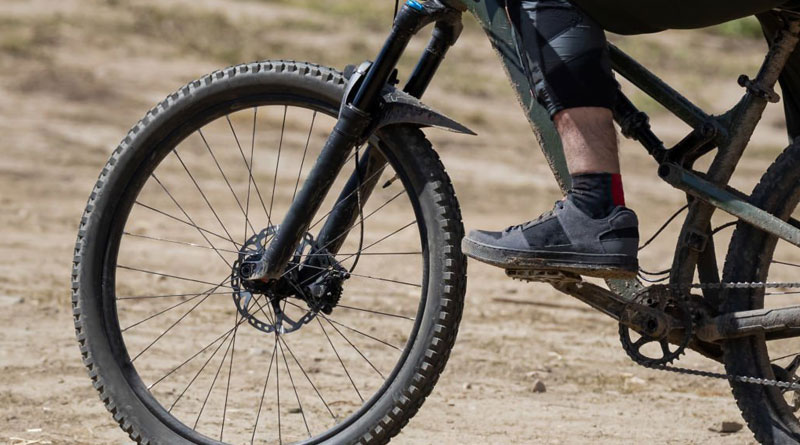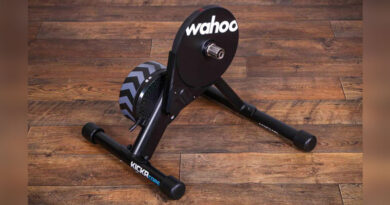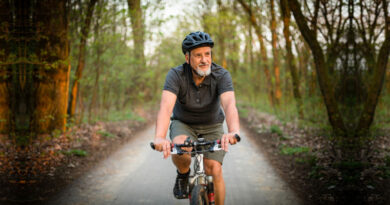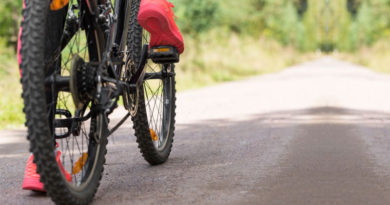Best Budget Mountain Bike Shoes of 2024
MTB shoes play a few important roles in terms of power transfer, efficiency, and foot protection. You have to be mindful of the different MTB disciplines when looking for MTB shoes. These disciplines have different requirements which the shoes are built around. For example, XC shoes are made for long and non-technical rides. Trail shoes are made for moderately rough terrains. Downhill shoes are made for the hardest terrain types. All these shoe types provide different levels of protection, power transfer, and efficiency. Then there are flat pedal and clipless shoes. Before buying MTB shoes make sure you do research on your riding conditions.
1. Giro Berm
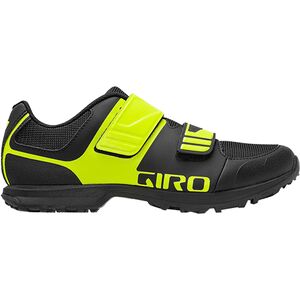
Cleat compatibility: 2-bolt
Upper: Synthetic fiber
Outsole: Rubber with an aggressive tread pattern
Weight: 1 lb. 13.2 oz.
If you are a beginner trying out clipless shoes or tight on budget, then the Giro Berm is a good option for you. Of course, when it comes to sports gear, Giro is no slouch, so, you can be sure that the Berm will be a good shoe.
The Berm has a sleek design that gives a lightweight first impression, which, it is. The grip of this shoe is excellent because the rubber sole has an aggressive tread pattern. The cleats are well recessed due to the treads which allows you to use a cleat cover to use the Berm as a flat pedal shoe. The sole provides 28mm for and aft adjustability which is a bit less compared to other shoes that normally provide 38mm of adjustability. The insole has less arch which makes the shoe feel flat.
The high-quality upper is synthetic and quick drying. There is a generous use of mesh panels which makes this shoe suitable for summer and hot weather use. Heels and toes are reinforced but the reinforcement is not as good as in other shoes, so, definitely room for improvement there. The heel cup and the cuff have good padding. But there is less padding in the tongue which may feel odd at first.
The closure system is just a couple of Velcro straps which is a bit lacking. While the straps do make it faster to take the shoe on and off, the hold is not confidence inspiring. The two straps, on their own, can’t provide a solid heel hold. But this is an excellent shoe for gravel and light trail riding.
What I like:
- Lightweight and sleek design
- Aggressive tread pattern for increased grip
- High-quality, quick-drying synthetic upper
What I don’t:
- Just a couple of Velcro straps don’t provide a perfect hold
- Insufficient arch support
- Reinforcement on the toe and heel can be improved.
2. Five Ten Freerider
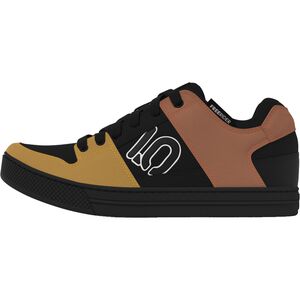
Cleat compatibility: Flat
Upper: Synthetic Leather/synthetic mesh
Outsole: Rubber
Weight: 1 lb. 11.6 oz.
It shouldn’t be an overstatement to say that the Five Ten Freerider and the Freerider Pro have become a benchmark for MTB shoes, especially flats. While the Freerider Pro is on the expensive side, the Freerider is an excellent budget flat pedal shoe. You can find it even cheaper in some cases with deals and sales making it an absolute steal.
The Freerider has a classic skate-shoe-like design. The outsole uses the same Stealth S1 rubber as in the more expensive Pro version. The rubber is soft with a dotted tread to provide excellent pin engagement on flat pedals. Use this shoe with sharp pins and you would get near clipless-like performance where you would actually feel the pins digging into the rubber. The off-the-bike grip is equally impressive. However, the non-aggressive tread pattern becomes slippery in wet and muddy conditions.
The upper is high-quality and made of suede leather recycled from waste. It features mesh panels that provide moderate breathability. Not only are the toes and heels reinforced but the sides just above the sole are also reinforced significantly increasing durability.
The upper and mesh are made to be abrasion resistant so durability is satisfactory overall except for the sole rubber. The sole rubber is soft and wears out faster than you would like. The shoe is on the heavier side which compromises the comfort of the shoe on long distances. It is only comfortable for short to medium distances. On long distances, the weight causes fatigue. However, with exceptional performance and high built quality, the Freerider is among the best value MTB shoes you can find.
What I like:
- Top-notch performance with an attractive price
- S1 Stealth rubber provides exceptional grip and pedal engagement
- Sides are also reinforced like the toe box and heel cup
What I don’t:
- The soft rubber sole wears out faster than you would like
- Non-aggressive tread pattern becomes slippery in wet and muddy conditions
- A bit heavy
3. Giro Gauge
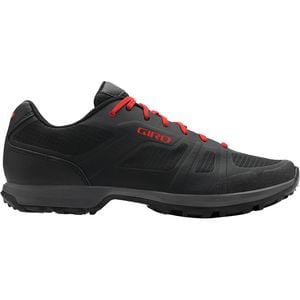
Cleat compatibility: 2-bolt
Upper: Thermo-bonded synthetic fibers/mesh
Outsole: Rubber
Weight: 1 lb. 12.6 oz.
The Giro Guage looks like a shoe designed for runners. That should give you an idea of what audience this shoe targets, that is, the XC market, should you miss it. The outsole has been carried over from the Giro Berm which tops this list. But a few positive changes to the outsole by Giro have completely changed the performance outcome of the Gauge.
The cleat adjustment is limited just like in the Berm. But the cleat shank is injected nylon for stiff pedaling performance. The shank also minimized the effects of the moderate flex that the outsole has. As a result, the Gauge provides adequate performance and is a great shoe for casual rides. But there is enough flex in the shoe that you can walk comfortably.
The upper of the Gauge has been made with abrasion resistance in mind. The stitchless upper consists of a thermo-bonded film that increases durability, keeps the shoe lightweight, and provides a better pedal feel. Giro claims that the upper material helps keep the shoe light. The shoe is light, but not featherlight. It weighs enough to keep reminding you that it’s there.
The shoe provides good breathability due to the mesh panels on the upper that are well thought out. Usually, mesh panels are vulnerable to tears and decrease the durability of the shoe. But the mesh in the Gauge is also abrasion resistant because of the thermo-bonded film in the rest of the upper. Giro has made sure that the Gauge lasts a long time.
What I like:
- Special focus on abrasion resistance
- Well-thought-out mesh inserts increase breathability
- Good pedal feel and power transfer
What I don’t:
- Same outsole limitations as in the Berm
- Mesh panels do decrease durability
4. Five Ten Trailcross Clip-in

Cleat compatibility: 2-bolt
Upper: Synthetic/textile
Outsole: Stealth Marathon rubber
Weight: 1 lb. 14.2 oz.
The Five Ten Trailcross lineup is a very popular and well-performing lineup. The lineup consists of the Trailcross LT, XT, Clip-in, Mid Pro, and Gore-Tex. The Trailcross Clip-in is a bit expensive for a budget shoe. But is one of the most versatile and performance-oriented clip-in shoes you will find which justifies the price tag to some extent.
The Trailcross lineup targets those that are into hike-a-bike-type adventures. It combines the best of mountain biking and walking shoes. The Clip-in has a walking/running shoe look and is essentially a clipless version of the Trailcross LT. The outsole uses the Stealth Marathon rubber which is a bit hard. It provides less grip – not an issue when clipped in – but it lasts longer off the bike. The rubber makes sense as it is for people doing some amount of walking on rough ground as well.
While the cleats get a lot of room for side-to-side adjustments, it doesn’t have room to move further back. Walking is fairly easy in the Trailcross Clip-in due to the EVA midsole. The shank also has EVA foam which further assists in walking. But the insole doesn’t provide enough arch support and you would be better with an aftermarket insole.
The upper is mostly mesh which makes this one of the most breathable and ventilated shoes. The toe box and the heel cup are reinforced and the sides are as well. A Velcro strap at the top further secures the foot along and also prevents the loosening of the laces. The Trailcross Clip-in won’t provide you with top-of-the-line performance. But it is a great shoe for fast riding and walking on the trail.
What I like:
- Harder Stealth Marathon rubber lasts longer than the softer Stealth S1 rubber
- Among the most breathable and ventilated shoes
- EVA foam in the shank and midsole increases comfort
What I don’t:
- The outsole isn’t as grippy as in the Freerider
- The mostly mesh upper is vulnerable to cuts and tears decreasing durability
- The insole doesn’t provide enough arch support
See the Five Ten Trailcross Clip-in
5. Ride Concepts Livewire
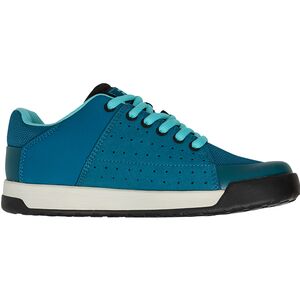
Cleat compatibility: Flat
Upper: Synthetic suede/nubuck
Outsole: Rubber Kinetics
Weight: 1 lb. 15 oz.
In our list of budget flat pedal shoes, we declared Ride Concepts Livewire as the best value shoe. This is an all-terrain shoe at a very attractive price point. The Livewire is a bulky shoe with a design similar to that of a skate shoe.
The performance of the outsole is excellent. It somehow manages to strike an almost perfect balance between grip, durability, and power transfer. The pedal feedback is just enough so that you feel connected to the terrain without getting fatigued. The soft rubber with hexagonal tread provides excellent pedal engagement. The moderate stiffness of the sole allows a balance between power transfer and walkability.
The whole shoe gives a high-quality and durable feel from the moment you look at it or hold it. But Livewire remains true to this feeling as well. The plush upper is welded to the sole with a nice finish which is where most MTB shoes fail. The gusseted tongue and reinforced lace eyelets, toe box, and heel cup make for a very durable shoe.
The mesh tongue and a mesh panel on the toe box make the shoe breathable to some extent. But the Livewire is not a shoe for hot weather. The weight of the shoe is also on the heavier side. While not noticeable during short and medium rides, but does cause discomfort on long rides and when going uphill. But you will be satisfied for the most part.
What I like:
- Almost perfect balance between grip, durability, and power transfer
- The weld between the upper and the sole has a nice finish
- Low price, increased comfort, and good performance make it one of the best value shoes
What I don’t:
- Heavier weight causes fatigue on long rides
- Limited breathability doesn’t make it suitable for hot weather
See the Ride Concepts Livewire
6. PEARL iZUMi X-Alp Flow
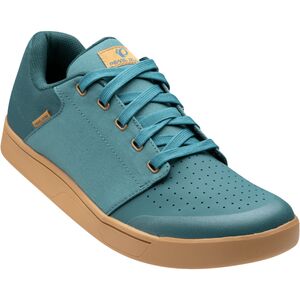
Cleat compatibility: Flat
Upper: Rubber/plastic
Outsole: Rubber/EVA
Weight: 1 lb. 8 oz.
The PEARL iZUMi X-Alp Flow targets the same audience as the Five Ten’s Trailcross. It is a shoe that is made for riders who are into hike-a-bike adventures. The X-Alp Flow is a popular shoe. But PEARL iZUMi has updated the design this time. I think they haven’t heard the phrase, “If it ain’t broken, don’t fix it”. But, perhaps, the company thinks it was broken so they decided to do something about it.
The previous iteration had a bulky design that looked more like a trail hiking shoe. But now, it has a more sneaker-like design. This iteration ditches the dual rubber outsole for a one-piece outsole and midsole design. But that has its own problems.
The previous iteration had hard and soft rubber for walking and pedal engagement. This iteration only has soft rubber in the outsole. While it makes walking easier and provides excellent grip, it wears out faster just like Five Ten’s Stealth S1 rubber. The soft rubber also compromises the power transfer to some extent.
The upper is plush – as it was – with some noticeable improvements. It’s the same lightweight breathable design with a reinforced toe box and heel cup. But the breathability has been increased with more perforations on the toe box. The tongue is now wide which allows the laces to have a better, more comfortable hold. The lace eyelets are also reinforced now. With a feature set like this, the X-Alp Flow costs a lot less than the Trailcross LT.
What I like:
- Lightweight design is inherently breathable
- More perforations in the updated design increase breathability
What I don’t:
- Softer outsole wears out faster like Five Ten’s Stealth S1 rubber
- Outsole also compromises power transfer
See the PEARL iZUMi X-Alp Flow
7. Five Ten Kestrel Lace

Cleat compatibility: 2-bolt
Upper: PU-coated synthetic laminate
Outsole: Rubber
Weight: 2 lbs. 0.6 oz.
The Five Ten Kestrel has a BOA closure system. The Kestrel Lace is a cheaper version of the Kestrel and, as the name suggests, it has a lace closure system. The Kestrel Lace is an all-mountain shoe that is great for enduro and all-mountain riders. It is among the new breed of mountain bike shoes that provide comfort, protection, walkability, and performance.
The outsole is stiff and the carbon-infused nylon shank further contributes to the stiffness. The power transfer is satisfactory and this shoe is great for hard sprints and steep climbs. The Kestrel Lace uses the C4 variant of the legendary Stealth rubber from Five Ten. You would expect that the grip would be great and you would be right. But a non-aggressive dotted tread loses traction in wet and muddy conditions.
The Kestrel Lace is a bulky shoe. The built quality of the shoe is impressive, as expected by Five Ten. The toe and the heel are reinforced. The outsole extends onto the toe box adding an extra layer of protection. But its bulk makes it heavy and that limits its breathability even though there are perforations on the toe box and in the mesh tongue. But the protection it provides makes up for the lack of breathability.
The shoe has a lot of room inside. The size runs big and the toe box is wide. The laces don’t go down enough so it is hard to get a tight fit around the ball and the toes. The insole is basic and thin, but functional. It is better if you get an aftermarket insole. Dense EVA cushioning gives a protected and plush feeling. As always, Five Ten has delivered another great shoe.
What I like:
- A stiff outsole ensures good power transfer
- The Stealth C4 rubber provides exceptional grip
- Among the most protective shoes
What I don’t:
- Dotted non-aggressive tread loses traction in wet and muddy conditions
- Laces don’t go down enough making it difficult to get a tight fit
- Limited breathability and heavier weight due to bulk
8. Shimano MT5

Cleat compatibility: 2-bolt
Upper: Mesh
Outsole: Rubber
Weight: 1 lb. 8 oz.
Seems like the MT5 is the only surviving member of the MT series by Shimano. As of this writing, only the MT5 is listed on Shimano’s website. It is, indeed, considered a great shoe among riders. So, Shimano decided to update the MT5’s design.
The MT5 has a sleek and aggressive design which makes you think that it is for fast riding. More appropriately, this shoe is great for free riding. While Shimano does advertise it as a performance-oriented shoe, it isn’t. But that doesn’t mean it is bad. It’s great for casual fast riding, just not for timed sprints.
The outsole is soft. Shimano rates it a 4 on its sole stiffness scale, whatever that is. But it does make walking easier. The aggressive tread pattern provides good grip while walking and also effectively recesses the cleats further aiding in walking. The power transfer is good for casual rides, but you will struggle going uphill or going fast.
The upper is where the updates have been made. The mesh panels have been increased which increases the breathability of the shoe and addresses the complaint regarding breathability. The lightweight design also contributes to breathability. The mesh is also abrasion resistant. The tongue width has been increased a bit and allows a better hold from the laces.
The MT5 is a great entry-level clipless shoe, good for those who are learning to ride with clipless shoes. Be careful when buying though. These shoes run small, which seems to be a common problem among Shimano shoes like the XCs, RXs, and some others.
What I like:
- Increased mesh panels improve breathability
- Soft rubber and aggressive tread provide a good off-bike grip
What I don’t:
- You would struggle with power transfer when going fast or uphill
- Size runs small
Best Budget Mountain Bike Shoes: Comparison Table
| SHOES | CLEAT | UPPER | OUTSOLE | WEIGHT |
|---|---|---|---|---|
| Giro Berm | 2-bolt | Synthetic fiber | Rubber | 1 lb. 13.2 oz. |
| Five Ten Freerider | Flat | Leather/mesh | Rubber | 1 lb. 11.6 oz. |
| Giro Gauge | 2-bolt | Synthetic fibers/mesh | Rubber | 1 lb. 12.6 oz. |
| Five Ten Trailcross Clip-in | 2-bolt | Synthetic/textile | Stealth Marathon rubber | 1 lb. 14.2 oz. |
| Ride Concepts Livewire | Flat | Synthetic suede/nubuck | Rubber Kinetics | 1 lb. 15 oz. |
| PEARL iZUMi X-Alp Flow | Flat | Rubber/plastic | Rubber/EVA | 1 lb. 8 oz. |
| Five Ten Kestrel Lace | 2-bolt | PU-coated laminate | Rubber | 2 lbs. 0.6 oz. |
| Shimano MT5 | 2-bolt | Mesh | Rubber | 1 lb. 8 oz. |
How to Choose Mountain Bike Shoes?
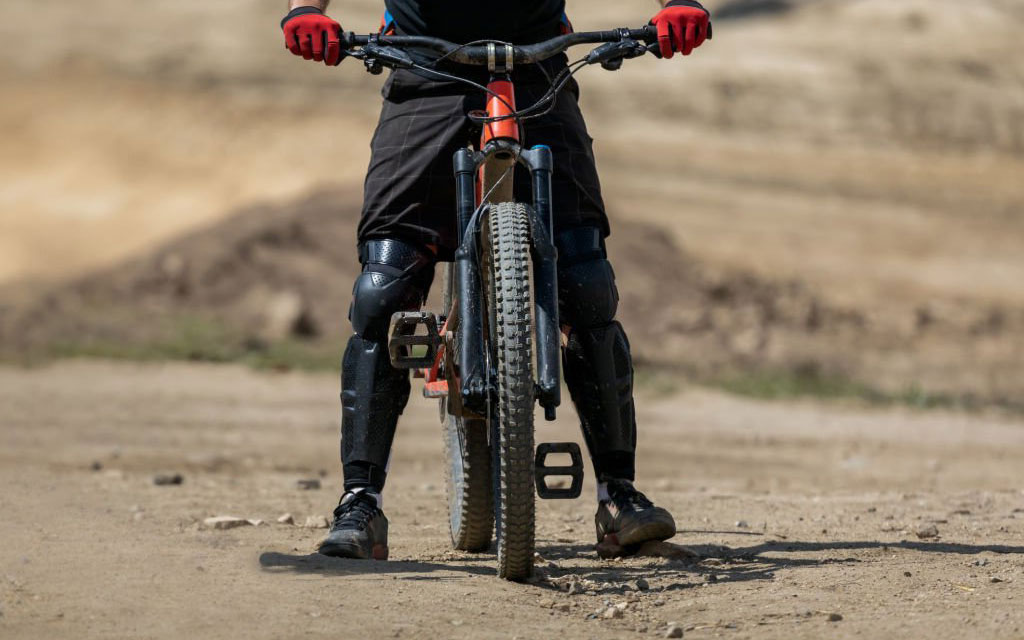
When looking to buy mountain bike shoes, there are a few things to keep in mind so that you get a pair that suits your needs. If you buy MTB shoes without research you may end up with a pair that doesn’t exactly cater to your needs. Here is a small guide on how to choose mountain bike shoes.
Clipless or Flat Pedals
The first decision you would have to make when choosing MTB shoes is whether you want clipless or flats. The decision depends on what your riding style is and what you are comfortable with. Since mountain biking has a few disciplines of its own, you need to be wise in your decision.
Flat pedal MTB shoes are better for technical trails. Technical trails provide more freedom to the feet which can be crucial when riding fast. Riders have to quickly and frequently put their feet down to avoid crashes and change directions instantly.
Clipless shoes can be used for all MTB disciplines. But they are more popular for pedal-intensive riding where power transfer and efficiency are important. Clipless shoes are common in gravel, uphill, and XC riders where the trails are usually less technical. But keep in mind that clipless shoes are uncomfortable for walking.
Fit
Fit is the most important aspect of any shoe. What’s the point of getting a shoe that doesn’t fit right? But in bike riding, the shoe fit also plays an important role in terms of efficiency and power transfer. Your mountain bike shoes should have a snug fit. They should feel like a glove and you shouldn’t feel pressure on any part of the foot.
A shoe too tight would obviously give you blisters and develop hot spots on your feet. You would feel extreme discomfort and pain. A shoe too big would compromise power transfer. The dangling shoe would absorb energy and you would have to pedal harder. On top of that, a bigger shoe also causes hotspots and blisters. The tongue and heel bite into the foot as the foot moves back and forth in the shoe. The lack of support also causes numbness and fatigue in the feet.
Retention System
MTB shoes have Velcro straps, laces, or BOA as retention systems. Velcro is usually used in combination with laces or BOA. Budget to intermediate shoes use laces or a combination of laces and Velcro straps. Although shoes like the Shimano XC1 and Giro Berm (tops this list) only use Velcro straps.
Premium and expensive shoes use a BOA retention system which is combined with Velcro straps in most cases. You should keep in mind that simple retention systems are easy and cheap to repair and replace if they get damaged. You can replace laces quickly and easily because they are widely available and cheaper to replace. Velcro is also cheap and the Velcro on Velcro straps can also be replaced if you reach out to a competent cobbler.
BOA is expensive and time taking to get repaired or replaced. BOA does provide a lifetime warranty and sends a free repair kit if reached out. However, you would have to contact the manufacturer for sewn or heat-welded parts.
Some manufacturers outright deny repairs, especially, if your shoe is under warranty. There are a few interests in doing so. To start with, it saves the company time and effort in case of a warranty claim. Secondly, who would buy new shoes if they all get repaired so easily?
Sole
There are two types of outsoles in MTB shoes: stiff or flexible. What sole you choose depends on your riding style and the terrain. Usually, sole stiffness is not a concern for gravity riders. They go for more pedal feel and foot protection. The sole tread and walkability are also important and should be kept in mind.
Weight and Protection
Lightweight bike shoes require less pedaling effort and cause less fatigue. But weight is not an important factor in MTB riding as it is in road riding where efficiency and power transfer are paramount. MTBs usually differ only a few ounces from one model to another.
XC shoes are focused on power transfer so they are thin. Trail shoes have intermediate cushioning to protect from trail falls. Gravity shoes are the bulkiest for utmost protection. They have better underfoot protection for shock absorption and more cushioning for increased comfort.
Mud and Water Resistance
Off-road trails commonly have dust, mud, and moisture. Water and mud resistance uppers make it easier to clean uppers and also provide peace of mind. However, shoes with such uppers are expensive and they also compromise breathability. Water and mud-resistant shoes are better for winter use. An alternative is to apply a waterproof coating.
Breathability
Manufacturers usually include perforations and mesh panels to make their shoes more breathable. But mesh compromises durability as it is vulnerable to tears and cuts. Mesh and perforations are not water resistant as well. Well-thought-out designs balance durability and breathability but the price of such shoes is often high.
Durability
MTBs are not exactly known for their durability. Soles commonly detach from the uppers. Flexible soles with soft rubber wear out faster when walking. But more durability means a higher price, like Sidi, which is known for its durable yet expensive shoes. Recently, however, manufacturers have significantly improved the durability of their MTB shoes.
Walkability
Backcountry and hike-a-bike adventures involve a lot of climbing and walking. Your MTB shoe should be efficient during pedaling and provide grip while walking. New MTB shoes have hybrid outsole designs that combine soft and stiff materials for pedaling performance and walkability. The toe box has flexible material which makes walking easier.

